
Classic Buses Profiles
London LTL AEC Renown - The single deck scooter (by Dick Gilbert)
Last updated 28 August 2022

SOME LINKS WITHIN THIS WEBSITE:
Home
Email
Links
THE COMPLETE WEBSITE MENU
Events Diary
Halfcab list
Small-Ads
Classic Irish Buses
Classic Manx Buses
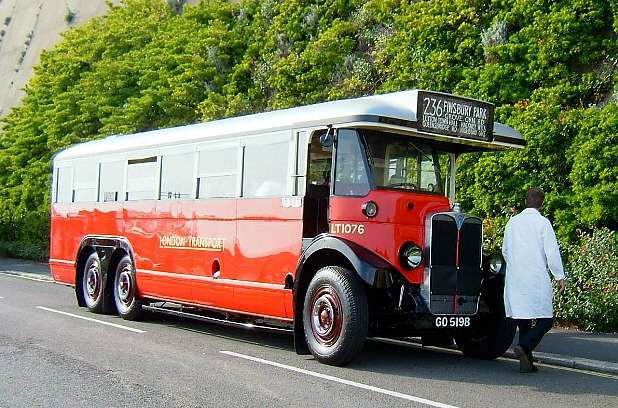
This picture, kindly supplied by John Perthen, and photographed at Brighton by his wife Margaret,
shows LT1076 from the London Transport Museum after years of careful restoration, on its first public outing - the Historic
Commercial Vehicle Society London-Brighton Run on 1 May 2005.
The London General Omnibus (LGOC) first introduced 3-axle/6-wheel vehicles in 1927 with the LS
(London Six) double deckers. Produced by the Daimler/AEC combine, they were the first double deckers with pneumatic tyres.
There were two main potential advantages to the 6-wheel arrangement. Firstly there was a legal
restriction at the time on the permitted weight per axle, which meant that the increase to six wheels would allow a heavier, longer,
and therefore larger capacity vehicle to be used. Secondly the two rear axles could both be driven by the engine, providing more
traction.
In August 1929 the prototype (LT1) of a double-deck AEC Renown 6-wheeler was delivered, proving to be
the precursor of a large and successful batch of buses that eventually ran to over 1400 vehicles. There was a somewhat dated air
about the vehicle, with its outside staircase, but such features were to be modernised as batch delivery got under way and the
designed evolved. Production vehicles started to arrive in 1930 and, slipped into the deliveries were five batches of single
deckers, also known by the designation LT, although their technical classification was LTL.
The single decker AEC Renown Model 664 was 29 feet 1 inch in length, and with an 18 ft 7 inch wheel
base, both measurements being slightly longer than their double deck relatives. All seated 35. Since the petrol engine was the same
as that installed in the double deckers, with the weight of the vehicle considerably less, the performance was quite sprightly.
This resulted in them being christened scooters by their drivers.
Three batches of single deck LTs were delivered for central area work, in lots of 50, 85 and 64
respectively, with all the buses painted red. In 1932 a pair of green vehicles were purchased for use on LGOC's country routes
(LT1427 and 1428). This made a total of 201 buses and coaches, and the whole lot were transferred from the LGOC to London
Transport on its formation on 1st July 1933. Lastly, a single private hire coach (LT1429) was transferred directly from Hillmans to
London Transport when its London operations were compulsorily acquired by LT in 1934.
With a typical design life of ten years for a bus at that time, none of the vehicles was expected to
be running past the mid-1940s, but the onset of war changed all that. Shortages of replacements resulted in buses all over the
country being required to soldier on well past their expected lives, and a large proportion of the single and double-deck LTs were
still running after the war. The ex-Hillmans private hire saloon had unfortunately succumbed to enemy action in 1940.
Over the next few years a process of body refurbishment took place, and 'Scooters' were converted
from petrol engines to oil. Some of the discarded petrol engines may have been used to extend the lives of other pre-war London
buses living on borrowed time. So, while the double deck LTs were being progressively retired (the last ones expiring at Upton Park
garage in January 1950), their single-deck counterparts were having life-extensions while waiting for delivery of the RF class
single deckers that were to replace them.
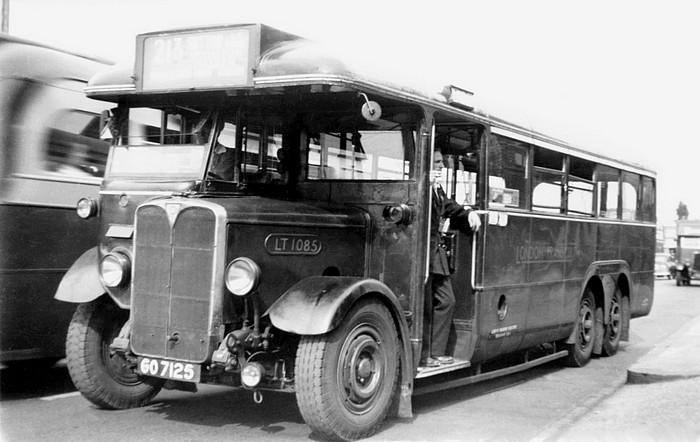
LT1085 (GO 7125) is seen on Route 213 heading for Sutton garage with something Green Line hurrying
by in the other direction. It looks as though this particular trip has finished, as there are no passengers on board and the
conductor is relaxing on the step with a cigarette. (Photo: unknown.)
The last of the LT scooters could still be seen operating from Bromley, Hounslow and Sutton garages
in the early 1950s, and were finally retired as replacement RF class buses came into service during 1952/53. None was formally
preserved, and it was generally considered that the type had disappeared without trace. One example of the double deck version
(LT165) was earmarked for preservation after the war, and can now be seen as part of the London Transport Collection.
Many enthusiasts were surprised, therefore, when two scooters (both from the second batch to be
delivered) suddenly appeared on the market some years ago. Although in extremely poor repair, such rare finds could not be ignored
by the preservation fraternity and both have subsequently gone to the best possible homes. LT1059 is now on
long-term restoration at the London Bus Museum, Brooklands, while the other
example (LT1076) passed to the London Transport Collection, and emerged fully restored in 2005 (see photo above).
Seeing a living, breathing scooter is an absolute delight for many enthusiasts, and a dream come true
of Jurassic Park proportions. The possibility of seeing TWO defies belief!
Henry Harwood wrote to me in 2014. He said "I spent the first twenty five years of my life growing
up at Plough Green, Worcester Park (1938 to 1963). Travelling on single deck LTs was part of my everyday life and it is wonderful
to see that LT1076 has been completely restored. Referring to route 213, which still operates to this day, the section between
Kingston and Sutton garage was at that period in history every 2/3 minutes interval, with every third bus extended to Belmont
station. Two out of every three buses terminated at Sutton Garage."
"The route was also worked after the war by T Class and TD class as well as a few forward entrance Q
class, some of the latter having a centre entrance having been transferred from country area use. Some of the single deck LTs came
back into service in 1945, from war office use during the war still retaining military grey livery. After the war with the shortage
of vehicles some hired private coaches also worked route 213 including OB Bedfords. Worcester Park was also served by route 127
with low bridge STs and after the war by utility D class and a few hired Bristol K5Gs from country operators, before the RLH type
buses took over. Sometimes I remember seeing an occasional Green Line Q and (I think) a T type operating route 213 in green country
or Green Line livery."
"The 213 route had everything; T, LT, TD and Q types and as a child because the service was so
frequent I used to make my mother wait with me at Kingston Garage until the type I wanted to return home on came in. I was in
Worcester Park last Sunday and the 213 today is using red biscuit-tin type vehicles, but it is good to see that this route more or
less has remained the same since the 1930s or before. Perhaps it should be celebrated by returning restored LT1076 to the route for
a day! I hope this information may be of interest." Thank you Henry.
Henry wrote again in November 2020, adding more memories; "I travelled on the London Transport LT
class single deck buses almost daily on route 213 which passed my front door, all through the second world war and up until their
replacements with the RF. I am now 82 years of age."
"With the shortage of buses at the end of the war, these and all other classes of buses were kept in
service well beyond their sell by date. Buses were in fact brought in from provincial operators to supplement the fleet and even
Bedford OB coaches from private companies were used on route 213. A number of the LT class that were getting to a point where they
were becoming bodily unserviceable, were sent to private coach builders for rebuilding. When they returned to service, they were
painted in the new brighter all-over post-war red livery."
"Some LT scooters were loaned to the War Office through the duration of the war, and these returned
to service with London Transport in 1945, still in their grey wartime livery. They were given to Kingston Garage and operated on
route 213 in their grey livery. Many of the T class also underwent private rebuilds and re-entered service in the new brighter all
over red post-war livery. Around 1947, the LT single deck class were re-engined from petrol to diesel engines." Thanks
again Henry. I wish I could have been there!
Many thanks also to Ian Smith for two excellent images to illustrate this profile.


FLEET LIST
LT1001-1050 (total 50)
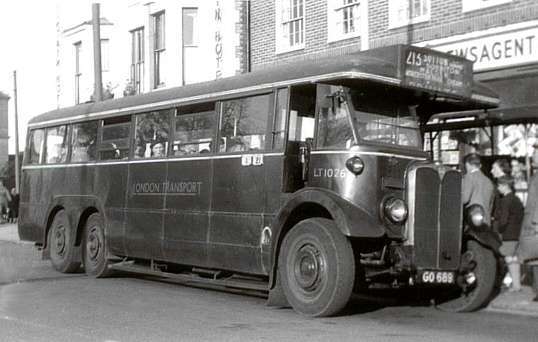
Thanks to Ian Armstrong's fine website about
London bus routes, we can track this picture down fairly accurately. LT1026 was based at Sutton depot in Bushey Road (A). It was
working route 213 which ran (at that time) Kingston - New Malden - Cheam - Sutton - Belmont, although on this occasion the bus was
only going as far as Sutton. LT single deckers shared this route with T-class Regals working out of Norbiton garage. At the rear of
the bus is the Fountain Hotel, which was (and still is) in Malden Road, New Malden, so we know exactly where the picture was taken.
The allocation number 21 on the side shows that it was taken on a weekday between May 1952 (when the allocation 21 came into use)
and May 1953 when RFs took over the route. It is reasonable to assume that this bus was not re-allocated elsewhere after that, so
we are seeing it in its last few months of service. Perhaps the photographer knew that, and that's why he was there. (Photo by kind
permission of Michael Rooum, London W1Y 2LP)
Delivered: January - April 1931
Chassis: AEC Renown 664 (1LT1), 110 mm bore engine. Survivors in 1950 converted to 7.7 litre / 95 bhp
diesel from scrapped STL class buses.
Chassis numbers: 664003 to 664052.
Body: 29 feet 5 inches long, B35F bodies, with central rear emergency door.
Notes: LT1001 delivered Jan 1931, all the others in April 1931. All red. Most allocated to Muswell
Hill, survived to 1952.
- LT1001 (GH 8049) c/n 664003, LGOC b/n 10327. Delivered to Hendon, then to Muswell Hill for Route 111. Withdrawn by 1952.
- LT1002 (GN 4775) c/n 664004, LGOC b/n 10330. Withdrawn by 1952.
- LT1003 (GN 4776) c/n 664005, LGOC b/n 10331. Withdrawn by 1952.
- LT1004 (GO 605) c/n 664006, LGOC b/n 10339. Withdrawn by 1952.
- LT1005 (GO 601) c/n 664007, LGOC b/n 10333. Delivered to Muswell Hill. Withdrawn by 1952.
- LT1006 (GN 4784) c/n 664008, LGOC b/n 10337. Rebuilt by Marshalls, Cambridge post-war.
- LT1007 (GO 606) c/n 664009, LGOC b/n 10338. Withdrawn by 1952.
- LT1008 (GN 4763) c/n 664010, LGOC b/n 10332.
- LT1009 (GN 4783) c/n 664011, LGOC b/n 10328. Rebuilt by Marshalls, Cambridge post-war.
- LT1010 (GO 637) c/n 664012, LGOC b/n 10347. Withdrawn by 1952.
- LT1011 (GN 4777) c/n 664013, LGOC b/n 10329. Rebuilt by Marshalls, Cambridge post-war.
- LT1012 (GO 625) c/n 664014, LGOC b/n 10342.
- LT1013 (GO 5114) c/n 664015, LGOC b/n 10376. Palmers Green garage 1948. Withdrawn by 1952.
- LT1014 (GO 614) c/n 664016, LGOC b/n 10336. Withdrawn by 1952.
- LT1015 (GO 648) c/n 664017, LGOC b/n 10353. Rebuilt by Marshalls, Cambridge post-war.
- LT1016 (GN 4785) c/n 664018, LGOC b/n 10334.
- LT1017 (GO 617) c/n 664019, LGOC b/n 10340. Withdrawn by 1952.
- LT1018 (GO 688) c/n 664020, LGOC b/n 10374. Rebuilt by Marshalls, Cambridge post-war.
- LT1019 (GO 626) c/n 664021, LGOC b/n 10372. Rebuilt by Marshalls, Cambridge post-war.
- LT1020 (GO 5113) c/n 664022, LGOC b/n 10375. Withdrawn by 1952.
- LT1021 (GO 607) c/n 664023, LGOC b/n 10335. Withdrawn by 1952.
- LT1022 (GO 641) c/n 664024, LGOC b/n 10360. Withdrawn by 1952.
- LT1023 (GO 631) c/n 664025, LGOC b/n 10344. Withdrawn by 1952.
- LT1024 (GO 630) c/n 664026, LGOC b/n 10346. Rebuilt by Marshalls, Cambridge post-war.
- LT1025 (GO 650) c/n 664027, LGOC b/n 10357. Rebuilt by Marshalls, Cambridge post-war.
- LT1026 (GO 689) c/n 664028, LGOC b/n 10373. Rebuilt by Marshalls, Cambridge post-war. Sutton depot 1952.
- LT1027 (GO 649) c/n 664029, LGOC b/n 10359. Withdrawn by 1952.
- LT1028 (GO 629) c/n 664030, LGOC b/n 10341. Rebuilt by Marshalls, Cambridge post-war. Sold to Nish, Serbia, Yugoslavia 1955
- LT1029 (GO 644) c/n 664031, LGOC b/n 10352. Sutton garage in 1950. Sold to Belgrade, Yugoslavia
- LT1030 (GO 628) c/n 664032, LGOC b/n 10350. Withdrawn by 1952.
- LT1031 (GO 638) c/n 664033, LGOC b/n 10348. Rebuilt by Marshalls, Cambridge post-war.
- LT1032 (GO 640) c/n 664034, LGOC b/n 10351. Withdrawn by 1952.
- LT1033 (GO 627) c/n 664035, LGOC b/n 10349. Delivered to Muswell Hill. Rebuilt by Marshalls, Cambridge post-war.
- LT1034 (GO 655) c/n 664036, LGOC b/n 10356. Withdrawn by 1952. Converted to caravan at Rayleigh, Essex.
- LT1035 (GO 642) c/n 664037, LGOC b/n 10345. Withdrawn by 1952.
- LT1036 (GO 639) c/n 664038, LGOC b/n 10343. Withdrawn by 1952.
- LT1037 (GO 672) c/n 664039, LGOC b/n 10368. Withdrawn by 1952.
- LT1038 (GO 643) c/n 664040, LGOC b/n 10354. Withdrawn by 1952.
- LT1039 (GO 668) c/n 664041, LGOC b/n 10364. Withdrawn by 1952.
- LT1040 (GO 656) c/n 664042, LGOC b/n 10355. Withdrawn by 1952.
- LT1041 (GO 684) c/n 664043, LGOC b/n 10370. Deliv 4/31, later with 7.7 litre oil engine, body not rebuilt, withdrawn 1952.
- LT1042 (GO 671) c/n 664044, LGOC b/n 10367. Withdrawn by 1952.
- LT1043 (GO 666) c/n 664045, LGOC b/n 10363. Withdrawn by 1952.
- LT1044 (GO 669) c/n 664046, LGOC b/n 10365. Withdrawn by 1952.
- LT1045 (GO 651) c/n 664047, LGOC b/n 10358. Converted to standee bus during the war. Rebuilt by Marshalls, Cambridge post-war and fitted with engine from an STL. To North's, Leeds for scrap.
- LT1046 (GO 667) c/n 664048, LGOC b/n 10361. Withdrawn by 1952.
- LT1047 (GO 673) c/n 664049, LGOC b/n 10369. Withdrawn by 1952.
- LT1048 (GO 670) c/n 664050, LGOC b/n 10366. Rebuilt by Marshalls, Cambridge post-war.
- LT1049 (GO 665) c/n 664051, LGOC b/n 10362.
- LT1050 (GO 685) c/n 664052, LGOC b/n 10371. Withdrawn by 1952.
LT1052-1136 (total 85)
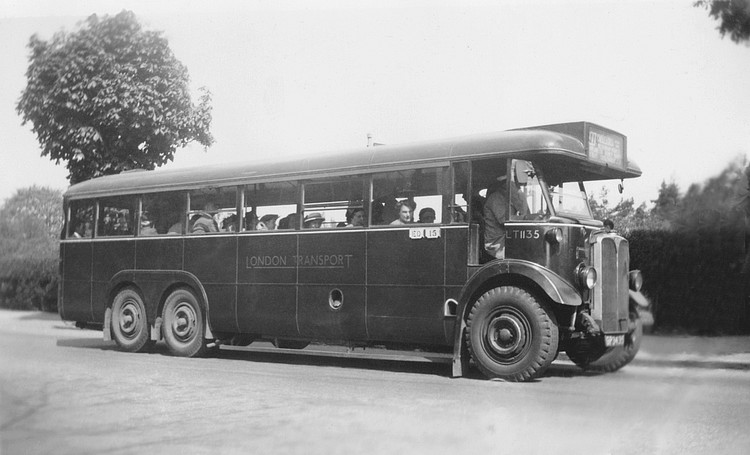
Elmers End-based LT1135 (GP 3435) on 13 May 1950 at Shortlands Station on Route 227 Penge-Shortlands-
Bromley-Chislehurst.
Photo from the Richard Haughey collection by kind permission. Photographer unknown.
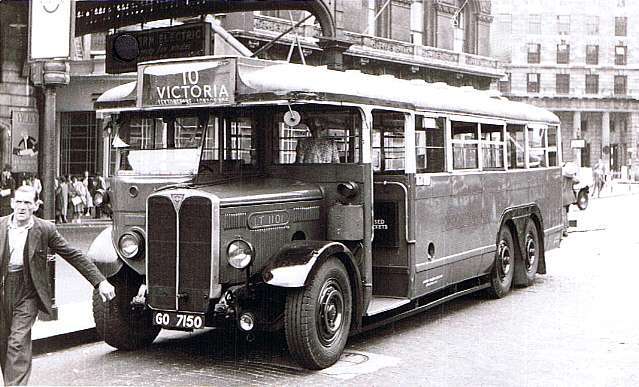
LT1101 (GO 7150) at Victoria Station. Allocated to Leyton depot, this bus is working route 10 which
ran from far-off Abridge via Chigwell, Leytonstone, Bow, and London Bridge to Victoria Station. RTs were running this route by 1950,
so it must be before that. It certainly appears to be in very good condition for a bus that was probably to be retired a couple of
years later. (Photo: London trolleybus preservation society)
Ray Wilkinson emailed me in 2012 and said "Most interesting website. I don't remember the scooters
although they were running in the area I lived in (at Wanstead) in the 1940s and 1950s. However, I do just remember the double-deck
LTs, primarily on route 10. My mother used to shop in George Lane, South Woodford and I remember seeing (and occasionally riding on)
the open-staircase LTs going to Abridge. That's why I found your photo of a single-deck LT on route 10 most intriguing; it was only
ever a double-deck route in my memory (and in all the other photos I've seen of the route)."
"Incidentally, the 10A, which went from Green Man, Leytonstone to Epping, couldn't get under the
railway bridge at Snaresbrook, so it went via the level crossing in Eagle Lane. When the central line was electrified, the road
under the bridge was lowered and the buses were re-routed under it, and the route number changed to 20."
"As for the LTLs, it wasn't until the mid 1950s that I discovered route 236 that ran at the back of
Leytonstone station (I knew the other side well!). By that time the LTLs had been replaced by Mann-Egerton TDs from T and AR
garages, and I did ride on them a couple of times."
Delivered: May-December 1931
Chassis: AEC Renown 664, 100 mm or 110 mm bore engine. Survivors in 1950 converted to 7.7 litre /
95 bhp diesel from scrapped STL class buses.
Chassis numbers; LT1052-1101; 664063 to 664112. LT1102-1136; 664114 to 664148.
Body: 29 feet 5 inches long, B35F bodies, with central rear emergency door, 1LT1 (Eleven were 1LT1/1
with front and rear destination boxes).
Notes: All red
- LT1052 (GO 5159) c/n 664063, LGOC b/n 12396. At Dalston garage for route 108D. Withdrawn by 1952. Converted to caravan at Herne Bay, then scrapped.
- LT1053 (GO 5169) c/n 664064, LGOC b/n 12388. To Dalston garage for route 108D. Withdrawn by 1952.
- LT1054 (GO 5171) c/n 664065, LGOC b/n 12399. To Dalston garage for route 108D. Withdrawn by 1952.
- LT1055 (GO 5161) c/n 664066, LGOC b/n 12389. To Dalston garage for route 108D. Withdrawn by 1952.
- LT1056 (GO 5160) c/n 664067, LGOC b/n 12395. To Dalston garage for route 108D. Withdrawn by 1952.
- LT1057 (GO 5162) c/n 664068, LGOC b/n 12391. To Dalston garage for route 108D. Rebuilt by Marshalls, Cambridge post-war.
- LT1058 (GO 5165) c/n 664069, LGOC b/n 12392. To Dalston garage for route 108D. Rebuilt by Marshalls, Cambridge post-war.
- LT1059 (GO 5170) c/n 664070, LGOC b/n 12390. Dalston garage for route 108D. Standee bus during the war. Withdrawn by 1952. Converted to caravan at Teignmouth. ** SURVIVOR **London Bus Museum, Brooklands, awaiting restoration when funds permit. Photo by Chris Stanley at Cobham museum, June 2008.
- LT1060 (GO 5166) c/n 664071, LGOC b/n 12394. To Dalston garage for route 108D.
- LT1061 (GO 5167) c/n 664072, LGOC b/n 12393. To Dalston garage for route 108D. Withdrawn by 1952.
- LT1062 (GO 5178) c/n 664073, LGOC b/n 12387. To Dalston garage for route 108D. Withdrawn by 1952.
- LT1063 (GO 5173) c/n 664074, LGOC b/n 12418. To Dalston garage for route 108D. Rebuilt by Marshalls, Cambridge post-war.
- LT1064 (GO 5176) c/n 664075, LGOC b/n 12412. Withdrawn by 1952.
- LT1065 (GO 5187) c/n 664076, LGOC b/n 12408. Withdrawn by 1952.
- LT1066 (GO 5175) c/n 664077, LGOC b/n 12419. Withdrawn by 1952.
- LT1067 (GO 5185) c/n 664078, LGOC b/n 12407. Withdrawn by 1952.
- LT1068 (GO 5192) c/n 664079, LGOC b/n 12404. Withdrawn by 1952.
- LT1069 (GO 5177) c/n 664080, LGOC b/n 12420. Rebuilt by Marshalls, Cambridge post-war.
- LT1070 (GO 5186) c/n 664081, LGOC b/n 12406. To Nunhead garage 1931 for route 621. Withdrawn by 1952.
- LT1071 (GO 5174) c/n 664082. LGOC b/n 12409. To Nunhead garage 1931 for route 621. Withdrawn by 1952.
- LT1072 (GO 7103) c/n 664083. LGOC b/n 12402. To Nunhead garage 1931 for route 621. Withdrawn by 1952.
- LT1073 (GO 5196) c/n 664084. LGOC b/n 12400. To Nunhead garage 1931 for route 621. Withdrawn by 1952.
- LT1074 (GO 5197) c/n 664085. LGOC b/n 12403. To Nunhead garage 1931 for route 621.
- LT1075 (GO 5199) c/n 664086. LGOC b/n 12413. Withdrawn by 1952. Converted to caravan at Herne Bay, then scrapped.
- LT1076 (GO 5198) c/n 664087. LGOC b/n 12398. To Bracknell (dealer) 5/50 and used as office. Converted to caravan at High Wycombe. ** SURVIVOR ** London Transport Collection.
- LT1077 (GO 7104) c/n 664088. LGOC b/n 12410. Withdrawn by 1952.
- LT1078 (GO 7141) c/n 664089. LGOC b/n 12421.
- LT1079 (GO 7102) c/n 664090. LGOC b/n 12405. To Nunhead garage 1931 for route 621. Withdrawn by 1952.
- LT1080 (GO 7151) c/n 664091. LGOC b/n 12427. Hounslow garage.
- LT1081 (GO 7121) c/n 664092. LGOC b/n 12928. Withdrawn by 1952.
- LT1082 (GO 7116) c/n 664093. LGOC b/n 12401. To Nunhead garage 1931 for route 621.
- LT1083 (GO 7119) c/n 664094. LGOC b/n 12424. Rebuilt by Marshalls, Cambridge post-war.
- LT1084 (GO 7129) c/n 664095. LGOC b/n 12415. Withdrawn by 1952.
- LT1085 (GO 7125) c/n 664096. LGOC b/n 12416. Rebuilt by Marshalls, Cambridge post-war.
- LT1086 (GO 7142) c/n 664097. LGOC b/n 12414. Withdrawn by 1952.
- LT1087 (GO 7120) c/n 664098. LGOC b/n 12430. Rebuilt by Marshalls, Cambridge post-war.
- LT1088 (GO 7117) c/n 664099. LGOC b/n 12397. To Nunhead garage 1931 for route 621. Withdrawn by 1952.
- LT1089 (GO 7118) c/n 664100. LGOC b/n 12431. Borehamwood 1934. Rebuilt by Marshalls, Cambridge post-war.
- LT1090 (GO 7128) c/n 664101. LGOC b/n 12411. Rebuilt by Marshalls, Cambridge post-war.
- LT1091 (GO 7135) c/n 664102. LGOC b/n 12417. Withdrawn by 1952.
- LT1092 (GO 7148) c/n 664103. LGOC b/n 12428. Withdrawn by 1952.
- LT1093 (GO 7149) c/n 664104. LGOC b/n 12429. Rebuilt by Marshalls, Cambridge post-war.
- LT1094 (GO 7145) c/n 664105. LGOC b/n 12425. Rebuilt by Marshalls, Cambridge post-war.
- LT1095 (GO 5200) c/n 664106. LGOC b/n 12435. Withdrawn by 1952.
- LT1096 (GO 7152) c/n 664107. LGOC b/n 12426. Rebuilt by Marshalls, Cambridge post-war.
- LT1097 (GO 7155) c/n 664108. LGOC b/n 12433. Withdrawn by 1952.
- LT1098 (GO 7144) c/n 664109. LGOC b/n 12423. Bromley garage. Sold to Nis, Serbia, Yugoslavia 1955, reregistered C 5563 with new front 'offside' door.
- LT1099 (GO 7146) c/n 664110. LGOC b/n 12422. Rebuilt by Marshalls, Cambridge post-war.
- LT1100 (GO 7147) c/n 664111. LGOC b/n 12432. Rebuilt by Marshalls, Cambridge post-war.
- LT1101 (GO 7150) c/n 664112. LGOC b/n 12434. Leyton garage 1940s. Withdrawn by 1952.
- LT1102 (GO 7161) c/n 664114. LGOC b/n 12929. Withdrawn by 1952.
- LT1103 (GO 7165) c/n 664115. LGOC b/n 12932.
- LT1104 (GO 7159) c/n 664116. LGOC b/n 11544.
- LT1105 (GO 7163) c/n 664117. LGOC b/n 12438.
- LT1106 (GO 7167) c/n 664118. LGOC b/n 12931. Rebuilt by Marshalls, Cambridge post-war.
- LT1107 (GO 7171) c/n 664119. LGOC b/n 12934.
- LT1108 (GO 7166) c/n 664120. LGOC b/n 12930. Withdrawn by 1952.
- LT1109 (GO 7158) c/n 664121. LGOC b/n 12436. Rebuilt by Marshalls, Cambridge post-war.
- LT1110 (GO 7162) c/n 664122. LGOC b/n 12437. Withdrawn by 1952.
- LT1111 (GO 7160) c/n 664123. LGOC b/n 12927. Withdrawn by 1952.
- LT1112 (GO 7172) c/n 664124. LGOC b/n 12939. Morden 1936 (red/white livery). ?Twickenham garage around 1950.
- LT1113 (GO 7173) c/n 664125. LGOC b/n 12935. Converted to oil engine June 1950, body not rebuilt, Sutton garage 1952
- LT1114 (GO 7186) c/n 664126. LGOC b/n 12950. Body renovated 1944/45 by Sunny Dawes Ltd of Southend, based at Bromley garage in 1952
- LT1115 (GO 7181) c/n 664127. LGOC b/n 12938. Withdrawn by 1952.
- LT1116 (GO 7179) c/n 664128. LGOC b/n 12949.
- LT1117 (GO 7184) c/n 664129. LGOC b/n 12955. Rebuilt by Marshalls, Cambridge post-war.
- LT1118 (GO 7180) c/n 664130. LGOC b/n 12947. Rebuilt by Marshalls, Cambridge post-war.
- LT1119 (GO 7177) c/n 664131. LGOC b/n 12936. Withdrawn by 1952.
- LT1120 (GO 7178) c/n 664132. LGOC b/n 12937. Withdrawn by 1952.
- LT1121 (GO 7185) c/n 664133. LGOC b/n 12953. Rebuilt by Marshalls, Cambridge post-war.
- LT1122 (GO 7192) c/n 664134. LGOC b/n 12943. Withdrawn by 1952. Converted to caravan at Benson, then scrapped.
- LT1123 (GP 3402) c/n 664135. LGOC b/n 12952. Rebuilt by Marshalls, Cambridge post-war.
- LT1124 (GP 3421) c/n 664136. LGOC b/n 12951. Withdrawn by 1952.
- LT1125 (GP 3401) c/n 664137. LGOC b/n 12941. Withdrawn by 1952.
- LT1126 (GP 3403) c/n 664138. LGOC b/n 12940. Withdrawn by 1952.
- LT1127 (GP 3406) c/n 664139. LGOC b/n 12954. Rebuilt by Marshalls, Cambridge post-war.
- LT1128 (GP 3405) c/n 664140. LGOC b/n 12946. Rebuilt by Marshalls, Cambridge post-war. Dalston garage around 1948
- LT1129 (GP 3404) c/n 664141. LGOC b/n 12945. Rebuilt by Marshalls, Cambridge post-war.
- LT1130 (GO 7200) c/n 664142. LGOC b/n 12942. Withdrawn by 1952.
- LT1131 (GP 3407) c/n 664143. LGOC b/n 12944. Body rebuilt post-war by Twiddy of Norwich. Leyton 1948, red/white livery. Muswell Hill garage around 1948-50. Bromley garage 1951.
- LT1132 (GP 3432) c/n 664144. LGOC b/n 12961. Withdrawn by 1952.
- LT1133 (GP 3425) c/n 664145. LGOC b/n 12948. Withdrawn by 1952.
- LT1134 (GP 3430) c/n 664146. LGOC b/n 12958. Withdrawn by 1952.
- LT1135 (GP 3435) c/n 664147. LGOC b/n 12967. Elmers End garage 1950.
- LT1136 (GP 3420) c/n 664148. LGOC b/n 12956. Elmers End garage 1950. Rebuilt by Marshalls, Cambridge post-war.
LT1138-1201 (total 64)
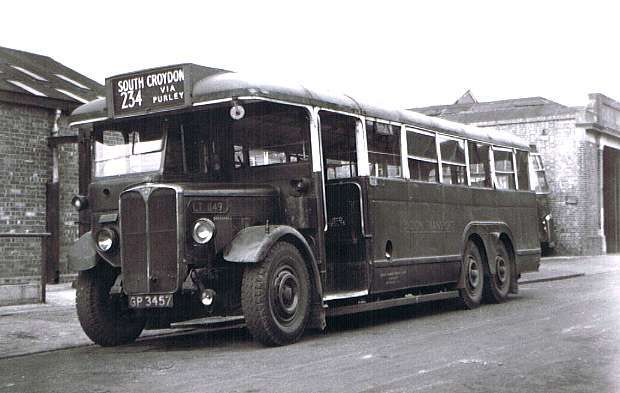
Croydon-based LT1149 (GP 3457) around 1947 before its rebuild by Marshalls of Cambridge. Route 234
ran Wallington - Purley - Selsdon, but this bus has obviously finished its working and gone back to the depot in London Road, South
Croydon (TC). (Photo by permission of Remember When, London W5 4NG)
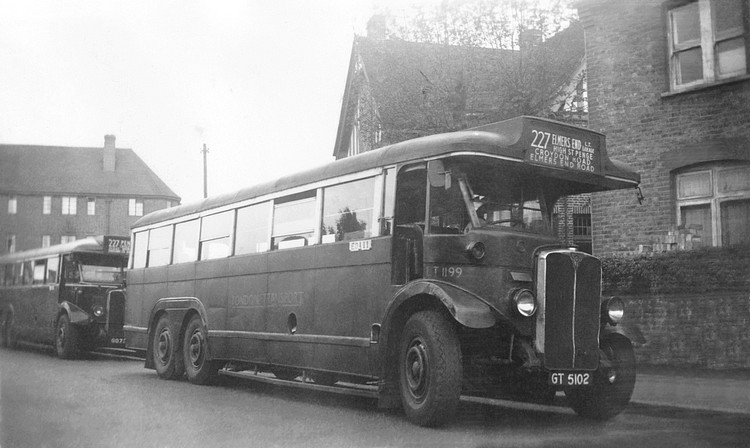
Elmers End-based LT1199 (GT 5102) on 20 May 1950 at Chislehurst, the end of Route 227 Penge-Beckenham-
Bromley-Chislehurst. Behind it is another 'scooter' on the same route, possibly LT1130 (GO 7200). Photo from the Richard
Haughey collection by kind permission. Photographer unknown.
Delivered: June-December 1931
Chassis: AEC Renown 664, 100 mm bore engine. Survivors in 1950 converted to 7.7 litre / 95 bhp diesel
from scrapped STL class buses.
Chassis numbers; 664150 to 664213.
Body: 29 feet 5 inches long, B35F bodies with central rear emergency door.
Notes: All red
- LT1138 (GP 3429) c/n 664150. LGOC b/n 12957. Withdrawn by 1952.
- LT1139 (GP 3433) c/n 664151. LGOC b/n 12960. Withdrawn by 1952.
- LT1140 (GP 3422) c/n 664152. LGOC b/n 12959.
- LT1141 (GP 3431) c/n 664153. LGOC b/n 12968. Withdrawn by 1952.
- LT1142 (GP 3454) c/n 664154. LGOC b/n 12964. Withdrawn by 1952. Became a caravan in Colchester in the 1950s.
- LT1143 (GP 3438) c/n 664155. LGOC b/n 12933. Rebuilt by Marshalls, Cambridge post-war. Bromley garage 1952, scrapped 1953
- LT1144 (GP 3434) c/n 664156. LGOC b/n 12962. Withdrawn by 1952.
- LT1145 (GP 3437) c/n 664157. LGOC b/n 12966. Withdrawn by 1952.
- LT1146 (GP 3439) c/n 664158. LGOC b/n 12965. Withdrawn by 1952.
- LT1147 (GP 3436) c/n 664159. LGOC b/n 12963. Withdrawn by 1952.
- LT1148 (GP 3448) c/n 664160. LGOC b/n 12969. Rebuilt by Marshalls, Cambridge post-war.
- LT1149 (GP 3457) c/n 664161. LGOC b/n 12971. Rebuilt by Marshalls, Cambridge post-war.
- LT1150 (GP 3455) c/n 664162. LGOC b/n 12970. Rebuilt by Marshalls, Cambridge post-war.
- LT1151 (GT 3485) c/n 664163. LGOC b/n 12972. Withdrawn by 1952.
- LT1152 (GT 5005) c/n 664164. LGOC b/n 12975. Rebuilt by Marshalls, Cambridge post-war.
- LT1153 (GT 5002) c/n 664165. LGOC b/n 12973.
- LT1154 (GT 5004) c/n 664166. LGOC b/n 12974. Withdrawn by 1952.
- LT1155 (GT 5008) c/n 664167. LGOC b/n 12979. Withdrawn by 1952.
- LT1156 (GT 5014) c/n 664168. LGOC b/n 12983. Withdrawn by 1952.
- LT1157 (GT 5003) c/n 664169. LGOC b/n 12976. Rebuilt by Marshalls, Cambridge post-war.
- LT1158 (GT 5006) c/n 664170. LGOC b/n 12977. Rebuilt by Marshalls, Cambridge post-war.
- LT1159 (GT 5015) c/n 664171. LGOC b/n 12981. Withdrawn by 1952.
- LT1160 (GT 5007) c/n 664172. LGOC b/n 12978.
- LT1161 (GT 5013) c/n 664173. LGOC b/n 12980.
- LT1162 (GT 5016) c/n 664174. LGOC b/n 12984. Dalston garage
- LT1163 (GT 5022) c/n 664175. LGOC b/n 12982. Rebuilt by Marshalls, Cambridge post-war.
- LT1164 (GT 5030) c/n 664176. LGOC b/n 12997. Rebuilt by Marshalls, Cambridge post-war.
- LT1165 (GT 5029) c/n 664177. LGOC b/n 12991. Withdrawn by 1952.
- LT1166 (GT 5028) c/n 664178. LGOC b/n 12986. Withdrawn by 1952.
- LT1167 (GT 5027) c/n 664179. LGOC b/n 12990. Rebuilt by Marshalls, Cambridge post-war.
- LT1168 (GT 5033) c/n 664180. LGOC b/n 12987. Body rebuilt by Marshalls, Cambridge 1950. Hounslow garage.
- LT1169 (GT 5031) c/n 664181. LGOC b/n 12985. Withdrawn by 1952.
- LT1170 (GT 5032) c/n 664182. LGOC b/n 12988. Withdrawn by 1952.
- LT1171 (GT 5034) c/n 664183. LGOC b/n 12989. Withdrawn by 1952.
- LT1172 (GT 5046) c/n 664184. LGOC b/n 12994. Rebuilt by Marshalls, Cambridge post-war.
- LT1173 (GT 5052) c/n 664185. LGOC b/n 12998. Rebuilt by Marshalls, Cambridge post-war.
- LT1174 (GT 5047) c/n 664186. LGOC b/n 12999. Withdrawn by 1952.
- LT1175 (GT 5044) c/n 664187. LGOC b/n 12996. Rebuilt by Marshalls, Cambridge post-war.
- LT1176 (GT 5045) c/n 664188. LGOC b/n 12993. Sutton garage 1950.
- LT1177 (GT 5054) c/n 664189. LGOC b/n 12992.
- LT1178 (GT 5053) c/n 664190. LGOC b/n 12995.
- LT1179 (GT 5059) c/n 664191. LGOC b/n 13000. Rebuilt by Marshalls, Cambridge post-war.
- LT1180 (GT 5060) c/n 664192. LGOC b/n 13003.
- LT1181 (GT 5061) c/n 664193. LGOC b/n 13006. Rebuilt by Marshalls, Cambridge post-war.
- LT1182 (GT 5079) c/n 664194. LGOC b/n 13009. Withdrawn by 1952.
- LT1183 (GT 5062) c/n 664195. LGOC b/n 13004. Withdrawn by 1952.
- LT1184 (GT 5074) c/n 664196. LGOC b/n 13005. Withdrawn by 1952.
- LT1185 (GT 5072) c/n 664197. LGOC b/n 13002.
- LT1186 (GT 5080) c/n 664198. LGOC b/n 13012. Rebuilt by Marshalls, Cambridge post-war. Kingston garage 1950
- LT1187 (GT 5075) c/n 664199. LGOC b/n 13008. Body rebuilt post-war by Marshalls, Cambridge, active 1952
- LT1188 (GT 5076) c/n 664200. LGOC b/n 13010.
- LT1189 (GT 5077) c/n 664201. LGOC b/n 13001. Withdrawn by 1952.
- LT1190 (GT 5078) c/n 664202. LGOC b/n 13007. Rebuilt by Marshalls, Cambridge post-war.
- LT1191 (GT 5098) c/n 664203. LGOC b/n 13014. Rebuilt by Marshalls, Cambridge post-war.
- LT1192 (GT 5090) c/n 664204. LGOC b/n 13013. Withdrawn by 1952.
- LT1193 (GT 5083) c/n 664205. LGOC b/n 13011. Sutton garage 1952
- LT1194 (GT 5145) c/n 664206. LGOC b/n 13022. Withdrawn by 1952.
- LT1195 (GT 5094) c/n 664207. LGOC b/n 13016. Dalston garage
- LT1196 (GT 5107) c/n 664208. LGOC b/n 13020. Withdrawn by 1952.
- LT1197 (GT 5100) c/n 664209. LGOC b/n 13017.
- LT1198 (GT 5101) c/n 664210. LGOC b/n 13015. Withdrawn by 1952.
- LT1199 (GT 5102) c/n 664211. LGOC b/n 13018. Elmers End garage 1950.
- LT1200 (GT 5108) c/n 664212. LGOC b/n 13019. Withdrawn by 1952. Became a caravan in the 1950s
- LT1201 (GT 5120) c/n 664213. LGOC b/n 13021. Hounslow garage 1952
LT1427/1428 (total 2)
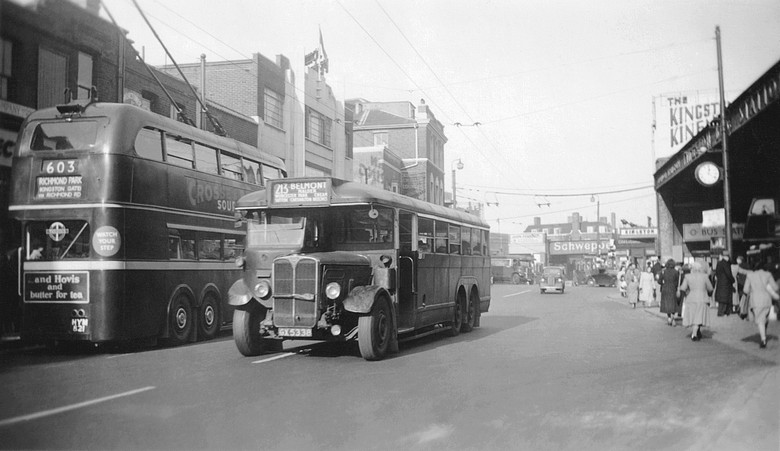
Two classic six wheelers pass in front of Kingston Bus Station on 18 February 1950. Kingston-based
LT1428 (GX 5338) on Route 213 Kingston-Sutton-Belmont passes trolleybus 1821 (HYM 821) on the 603, Tolworth to Tolworth via the
Kingston Hill loop. Photo from the Richard Haughey collection by kind permission. Photographer unknown.
Delivered: August 1932
Chassis: AEC Renown 664.
Body: B35F bodies.
Notes: Both green, delivered in 1932 to London General Country Services, passed in 1933 to Country
Department of London Transport (the only scooters used in the Country area), transferred to Central Area in 1944 and painted red.
Converted to oil engines in 1949/50.(2LTL3)
- LT1427 (GX 5337) c/n 664224, LGOC b/n 13442. Dorking garage 1936, used on Route 425 to Guildford. Still active 1952.
- LT1428 (GX 5338) c/n 664225, LGOC b/n 13441. Dorking garage 1936, used on Route 425 to Guildford. At Kingston on Route 213 in 1950. Still active 1952.
LT1429 (total 1)
Ex Edward Hillman of Romford, private hire saloon as their No.119.
Body: Harrington C32F body, 30 feet long, sliding door.












